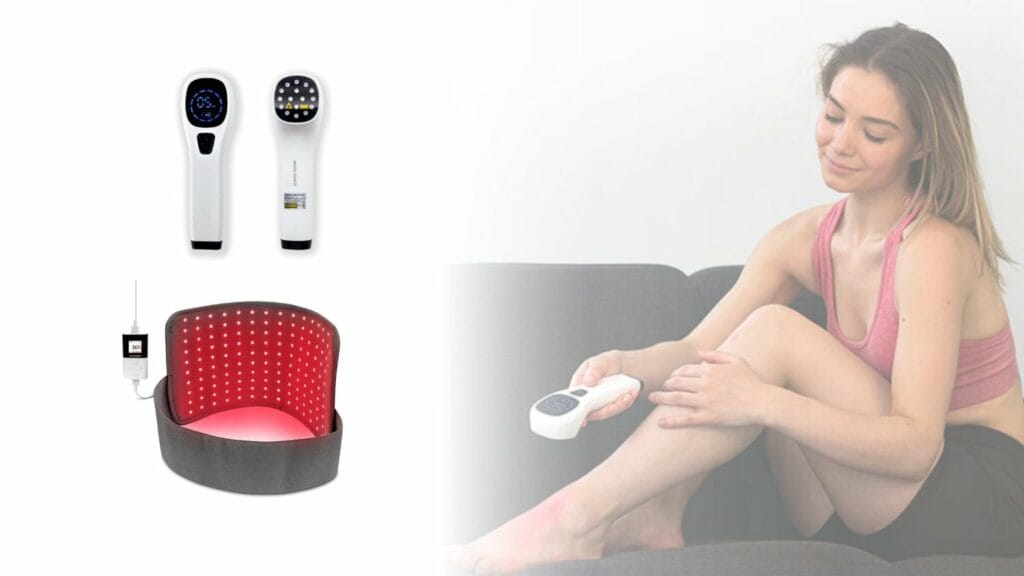How Red Light Therapy Relieves Joint Pain Symptoms Effectively
We include links to products we think are useful for our readers. If you click and buy a product through one of the affiliate links on this page, we may earn a small commission.

Joint pain affects every part of your day, from opening jars to walking your dog in the park.
You might have tried all sorts of remedies—medications, exercises, even special diets. Now, there’s another option you might not have considered yet: red light therapy. This treatment stands out because it’s gentle and non-invasive, aiming to ease your pain and calm inflammation without drugs or surgery.
In this article, let’s get into how red light therapy could help manage your joint pain, whether from arthritis or other conditions. We’ll see how it works and the potential benefits it brings.
Key Takeaways
Red light therapy stimulates cellular activity and increases ATP production, accelerating recovery and reducing joint inflammation.
Red light therapy is particularly beneficial for arthritis, enhancing joint function and reducing discomfort.
Beyond pain relief, red light therapy promotes collagen production, crucial for joint and cartilage health, and improves blood circulation.
This particular therapy is a safe, non-invasive treatment that can be administered at home with portable devices, offering a practical alternative to traditional pain relief methods.
How Red Light Therapy Works Against Joint Pain
Red light therapy (RLT) is an emerging treatment gaining attention for its role in managing pain, especially chronic joint pain. The therapy involves exposing the body to low wavelengths of red or near-infrared light. Intriguingly, this light penetrates the skin, reaching muscles and bones without causing any pain or discomfort.
At its core, the mechanism of red light therapy is based on its ability to stimulate cellular activity. When cells absorb the light, it triggers a series of biological reactions. One significant effect is the increase in the production of adenosine triphosphate (ATP), the energy currency of cells. This boost in ATP production enhances cellular function and promotes healing. For those dealing with chronic pain, this means that the body’s repair mechanisms get a helping hand, accelerating the recovery processes that can alleviate pain and reduce inflammation.
Research supports these claims, with various studies indicating that patients experiencing different types of pain report significant relief after undergoing red light therapy. For instance, a clinical trial found that people with knee osteoarthritis saw reduced pain and increased function after regular RLT sessions. The therapy has also been shown to improve blood circulation, which further helps in pain management and tissue repair.
Furthermore, RLT is known for its ability to stimulate collagen production, which is crucial for maintaining joint and cartilage health. Collagen is a vital protein that helps maintain our joints’ elasticity and strength. Increased collagen production supports joint structure and can lead to decreased pain and better joint function.
However, it’s not a standalone cure. It works best when integrated into a broader treatment plan that may include physical therapy, medication, and lifestyle changes. The procedure itself is usually administered through devices that emit red light directly onto the skin. These can range from large professional units to portable home devices, offering flexibility in how and where treatment can be received.
Understanding Joint Pain Causes

Joint pain affects millions of people and can significantly impact quality of life. This discomfort may arise from various conditions, with arthritis being a primary cause. However, joint pain can also stem from other sources such as injuries or wear and tear.
Red light therapy (RLT) has emerged as a promising treatment option for these symptoms, attracting attention for its potential to relieve pain and enhance joint function.
Types of Arthritis and Their Impact on Joints
Arthritis encompasses over 100 different types, but the most common are osteoarthritis (OA) and rheumatoid arthritis (RA).
Osteoarthritis is characterized by the breakdown of cartilage, the cushiony material at the end of bones. As the cartilage wears away, bones rub against each other, causing pain, swelling, and restricted movement. This wear and tear typically occur in the joints most frequently used, such as the hands, knees, hips, and spine.
Rheumatoid arthritis is an autoimmune disorder where the body’s immune system attacks its tissues, affecting the lining of the joints (synovium). This can lead to severe pain and can eventually cause joint deformity and erosion. RA often affects joints symmetrically (e.g., both knees or both hands).
Both types lead to significant discomfort and disability, impacting individuals’ ability to perform everyday activities.
Common Non-Arthritis Causes of Joint Pain
Apart from arthritis, other factors can contribute to joint pain:
Injuries: Sprains and strains from sports, accidents, or falls can cause temporary but acute joint pain.
Wear and Tear: Overuse of a joint during work or sports can lead to tendinitis or bursitis, inflaming the tendons and cushions around joints, respectively.
Infections: Sometimes, the joint itself can become infected, leading to pain, swelling, and redness, a condition known as septic arthritis.
Benefits of Red Light Therapy for Joint Pain

A notable study by NovaaLab, involving 205 participants, underscores the patient-perceived benefits of red light therapy. According to the survey:
47% of the participants reported relief from symptoms of joint pain.
46% reported a reduction in inflammation.
37% experienced eased symptoms of arthritis.
Additionally, 45% of participants stated that they had moderate pain levels before they tried red light therapy, 29% experienced severe pain levels, while 6% had the worst. After the product trials, participants with moderate pain levels reported levels reduced to 25%, 4% to severe, and virtually zero for the worst pain levels. That’s an astonishing difference in numbers!
These findings highlight the significant impact of RLT on improving joint health and underscore its potential as a valuable treatment option for those suffering from joint pain and related conditions.
But how? What makes blasting red light on your concerned areas help alleviate joint pain?
Let’s explore these benefits in detail.
Reduction of Inflammation and Its Effect on Joint Pain
One of the primary benefits of red light therapy is its capacity to reduce inflammation, a significant contributor to joint pain. Inflammation is the body’s natural response to injury or disease, involving the release of inflammatory cytokines and increased blood flow to the affected area. While this is a part of the healing process, persistent inflammation can lead to chronic pain and degeneration of joint tissues.
RLT works by emitting photons that are absorbed by mitochondria, the energy-producing organelles in cells. This absorption enhances mitochondrial function, boosting the cell’s energy production and reducing the release of inflammatory agents. As a result, there is a significant decrease in inflammation, which directly correlates with a reduction in pain and discomfort in the joints.
Clinical studies have consistently shown that patients undergoing RLT experience a noticeable reduction in inflammatory markers, translating to less pain and improved joint function.
Stimulation of Cellular Repair and Health
The ability of RLT to stimulate cellular repair and health is another cornerstone of its effectiveness in treating joint pain. By enhancing mitochondrial activity, RLT promotes the regeneration of cells, including those constituting cartilage, tendons, and ligaments. This regenerative effect not only helps in repairing damaged tissues but also in maintaining the health of existing cells, thus preventing further degeneration.
This aspect of RLT is crucial for conditions like osteoarthritis, where the degradation of cartilage leads to joint pain and stiffness. By fostering cellular health, RLT can slow the progression of such conditions and alleviate symptoms, allowing for better mobility and quality of life.
Improvement in Circulation and Its Benefits for Joint Health
Improving circulation is another significant benefit of red light therapy that contributes to its effectiveness in treating joint pain. Enhanced blood flow ensures that more oxygen and nutrients are delivered to damaged tissues, which is crucial for healing and recovery. Additionally, improved circulation helps in the removal of waste products from the cells, which can accumulate and exacerbate inflammation and pain.
The circulatory benefits of RLT can lead to faster recovery times from joint injuries and a noticeable improvement in overall joint health and functionality. This is particularly beneficial for individuals with chronic joint conditions, as improved circulation can help manage symptoms and reduce the frequency of flare-ups.
Recommended Red Light Therapy Products for Joint Paint
The following products ranked the highest during Novaalab’s survey for the most effective against joint pain, arthritis, and inflammation.
Novaa Extra-Strength Healing Laser
Novaalab’s strongest portable deep healing therapy. Portable and works efficiently
I recently discovered the Novaa Extra-Strength Healing Laser, and it’s proven to be an outstanding investment for managing my joint pain. This portable device harnesses the power of red light therapy, which is clinically recognized for its efficacy in reducing inflammation and pain associated with joint and muscle discomfort.
What makes this laser particularly appealing is its portability. It’s lightweight and compact, allowing me to use it anywhere—at home, at work, or even while traveling.
For $249, the Novaa Laser is a valuable health investment. Considering the costs associated with physical therapy sessions, medications, and other pain management techniques that often come with side effects, this one-time purchase feels economically sensible.
Read my Novaa Extra-Strength Healing Laser review here for a more detailed experience.
Novaa Light Pad XL
Novaalab’s biggest red light therapy panel. Maximize the coverage and benefits of RLT.
Although a bit pricier than the portable laser, it’s worth every penny for the extensive coverage it provides. This pad is designed to target larger areas of the body, like the back and legs, making it ideal for joint pain relief.
The Novaa Light Pad’s wide scope allows it to envelop the affected areas completely, delivering red and near-infrared light deep into the tissues. This widespread application is important for stimulating healing across a broader region, which is particularly beneficial if you suffer from multiple joint issues simultaneously. The light penetrates the skin, reaching the joints and muscles, enhancing circulation, reducing inflammation, and promoting recovery.
Personally, the convenience of laying the pad on any painful area and letting it work its magic without having to move a muscle is a game-changer. It’s like having a professional treatment session at home, saving me time and money in the long run. The initial investment might seem high, but compared to ongoing therapy costs, it’s definitely cost-effective, especially considering the relief and mobility it restores.
Why Red Light Therapy is Better Than Other Treatments
When comparing red light therapy (RLT) with traditional joint pain relief methods, RLT stands out for several reasons. Firstly, RLT offers a non-invasive approach, unlike some conventional treatments that might involve drugs or surgical interventions. This makes RLT a safer option with fewer side effects. Common treatments like medication can lead to gastrointestinal issues, dependency, or other systemic effects, while RLT generally has minimal side effects, typically restricted to mild irritation or redness at the site of application.
Furthermore, RLT promotes natural healing by enhancing cellular function and increasing circulation, which is not directly addressed by painkillers or anti-inflammatory drugs. These traditional medications generally provide symptomatic relief without necessarily promoting tissue repair.
The effectiveness of RLT in reducing inflammation and pain is backed by scientific research, making it a viable option for the long-term management of chronic joint conditions like arthritis. This contrast with, for example, steroid injections, which can degrade joint cartilage over time, highlights RLT as a sustainable treatment alternative.
Frequently Asked Questions
Red light therapy uses specific wavelengths of light to penetrate tissues and promote healing, reducing joint pain and inflammation.
Yes, it’s a non-invasive treatment with minimal side effects, primarily used for pain relief and tissue repair.
Treatments are generally recommended 2-3 times per week, depending on the severity of the symptoms.
Side effects are rare but may include temporary redness or irritation at the treatment site.
While it can reduce pain and inflammation, it’s best used as a complementary treatment alongside your current medications.
Improvements can be noticed as early as a few weeks with consistent treatment.
There are many FDA-approved devices like Novaalab products for home use that are effective and safe.
Item description
Conclusion
Red light therapy (RLT) emerges as a compelling alternative for those struggling with joint pain, offering a safe and non-invasive way to alleviate discomfort and improve mobility. By enhancing cellular function and reducing inflammation, RLT supports the body’s natural healing processes. The effectiveness of RLT, coupled with its ease of use at home, makes it an accessible option for many seeking relief from chronic joint conditions.
As you consider different treatments for joint pain, isn’t it worth exploring how red light therapy could improve your quality of life?
References
Chen, P., Zou, Y., Liu, Y., Han, W., Zhang, M., & Wu, Y. (2024). Low-level photodynamic therapy in chronic wounds. Photodynamic Therapy. Elsevier. https://www.sciencedirect.com/science/article/pii/S1572100024001224
NovaaLab. (2024). Phase 1 survey findings. NovaaLab.
Photonic Therapy Institute. Learn About Light Therapy. Sonoita, AZ, 2024. Available from: https://photonictherapyinstitute.com [Last accessed: April 02, 2024].

